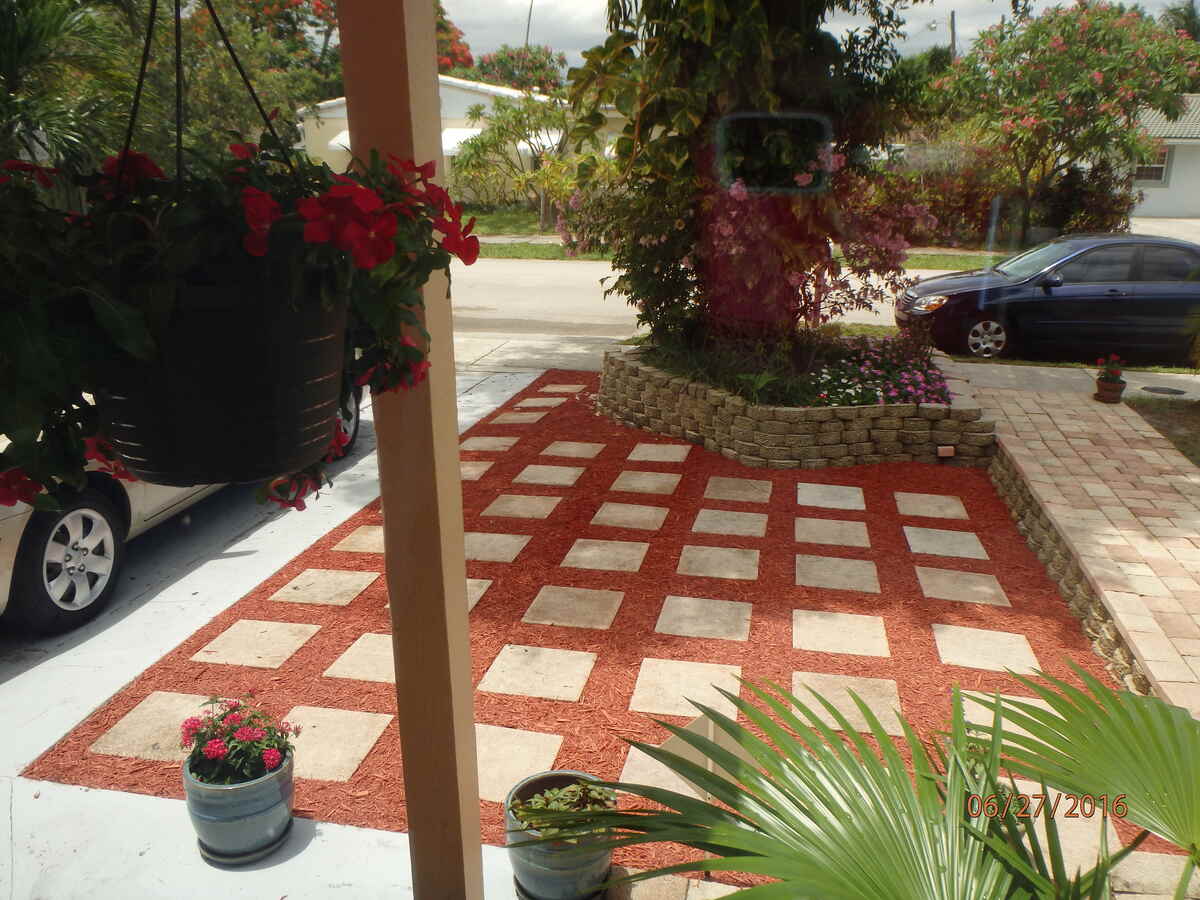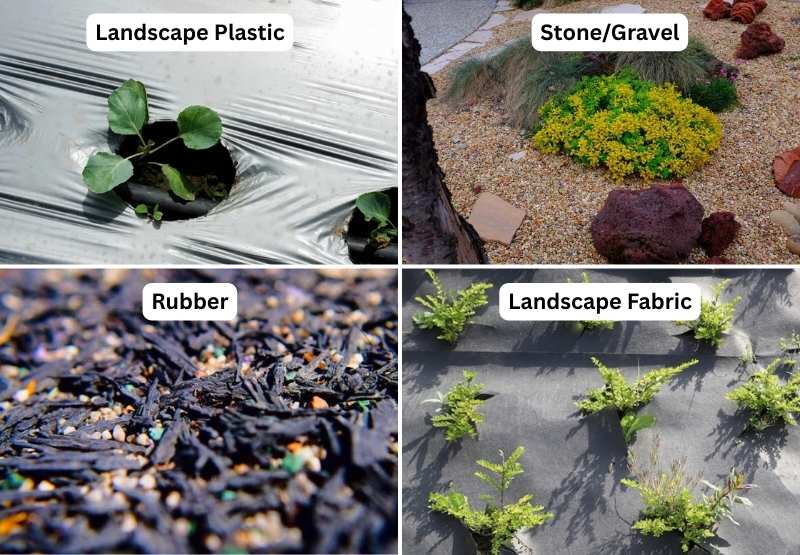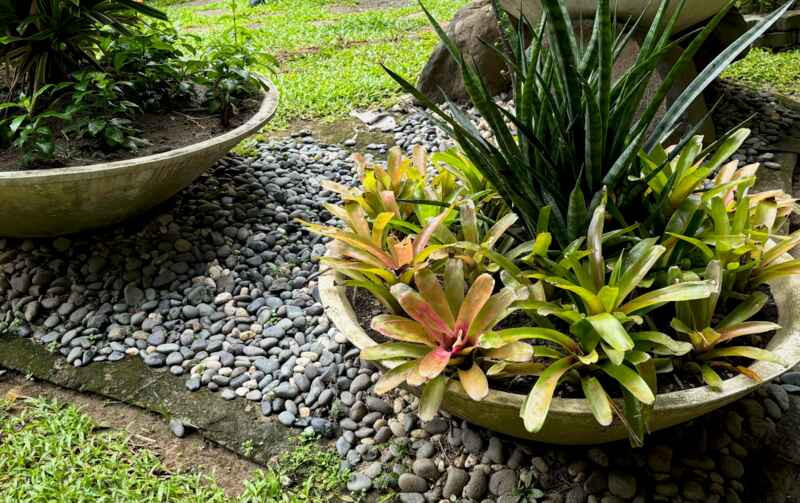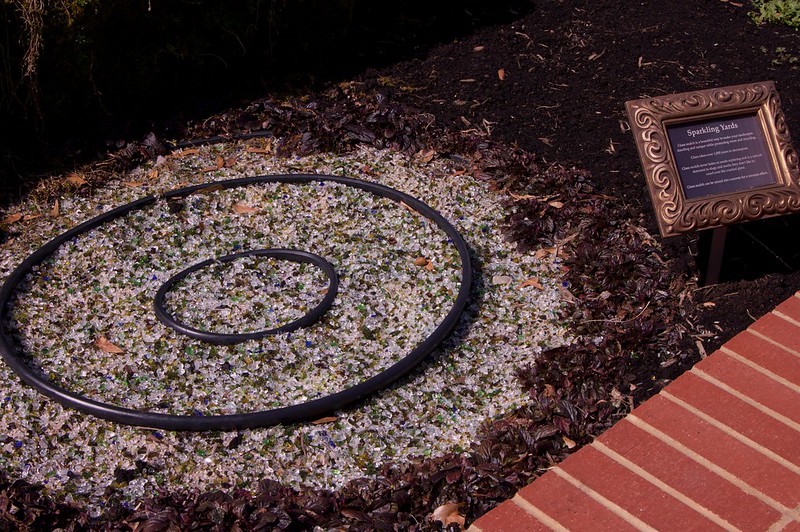
It may seem trivial, but mulch does a great job of transforming landscapes beyond mere aesthetics. Depending on the type of mulch, it can help retain soil moisture, suppress weeds, and more.
Whether you want an organic or inorganic mulch for your landscape, learn more about the different types of mulch — from wood chips to corncobs and stone to recycled tumbled glass.
Organic vs. Inorganic Mulch
There are various types of mulch, with each falling into either of the two classifications: organic or inorganic. The difference between organic and inorganic mulches is in their composition and decomposition.
Organic mulch: Derived from plant or animal matter, organic mulches decompose fast and add nutrients to the soil.
Inorganic mulch: Mostly derived from non-living materials, inorganic mulches decompose slowly, if at all. This makes them last longer than organic mulch, lessening the need for frequent replacements.
Pro Tip: Some homeowners prefer green mulch or living mulch, which involves covering the soil with a dense layer of low-growing plants like clover, calendula, and sedges. If you’d rather have green mulch or another mulch alternative, you can hire a landscaping professional to help determine the best option for your landscape.
See Related: How Often Should You Replace Mulch?
Organic Mulch Types


Wood Mulch: Nathanael Asaro / Adobe Stock Free / License
Tree Bark: Pixabay
Pine Needles: Pixabay
Straw: Pxhere
Wood Chips: Shadowmeld Photography / Wikimedia Commons / CC BY-SA 4.0
Leaves: Pxhere
Sawdust: Pixabay
Grass Clippings: Darren Lewis / PublicDomainPictures / CC0
Compost: Oregon State University / Flickr / CC BY-SA 2.0
Organic mulches have become more popular these days because they can help nurture your yard with little to no environmental impact. You can choose from this list of organic mulches recommended by most experts. Click on the type in the table below to skip to that section.
Wood Chips
Made from shredded wood and tree trimmings, wood chips tend to interlock, reducing the possibility of getting washed away.
- Appearance: Natural, chunky texture; available in various colors like brown, red, and black
- Durability: Long-lasting (1 to 3 years)
- Best for: Flower beds, garden paths, and around trees and shrubs
- Benefits: Excellent moisture retention, weed control, and soil insulation
- Considerations: It may be the best mulch for flower beds, but it can deplete nitrogen from the soil once it decomposes, as microorganisms need nitrogen to break down this material
Pine Needles
Also called pine straw, pine needles are a lightweight mulch collected from coniferous pine trees. They create a light and airy layer, allowing water to penetrate while suppressing weed growth.
- Appearance: Thin and needle-like; colors can vary from light brown to reddish-brown
- Durability: Average (6 to 12 months)
- Benefits: Effective weed control, good soil insulating properties, and adds a rustic look to landscapes
Grass Clippings
For free mulch, you might want to consider using grass clippings, as you can easily obtain them by mowing your lawn. They’re rich in nitrogen, which helps feed your lawn and garden plants.
- Appearance: Green when freshly cut, turning brown as they dry
- Durability: Short (a few weeks to 2 months)
- Best for: Lawns, vegetable gardens, and flower beds
- Considerations: Can mat and limit water absorption if applied too thickly
Shredded Leaves
Money doesn’t grow on trees, but free mulch does. If your yard is always littered with fallen leaves in the fall, you can mulch them with a mulching mower.
- Appearance: Leaf fragments in various autumn colors
- Durability: Average (6 to 12 months before turning into leaf mold)
- Considerations: Can be blown away
Leaf Mold
Once leaves decompose, they break down into leaf mold. This resulting soft, rich material is one of the best types of mulch for flower beds and vegetable gardens.
- Appearance: Crumbly texture (almost similar to compost); dark brown to black
- Durability: Long-lasting (1 to 3 years)
- Best for: Lawns, flower beds, and vegetable gardens
- Benefits: Exceptional moisture retention, adds beneficial fungi that help improve the soil
- Considerations: It can take time to prepare this mulch type, as you’ll need to wait for leaves to decompose
Note: If you don’t know how to make leaf mold, you can check out this video:
Newspaper
Shredded types of mulch, like newspaper, can help retain soil moisture. But if you add it as whole sheets, it can be an excellent weed barrier that’s inexpensive and eco-friendly.
- Appearance: Flat sheet; black and off-white (turns more gray over time)
- Durability: Short (3 to 6 months)
- Best for: Perfect for weed suppression, especially in vegetable gardens
- Benefits: Can block sunlight from reaching weed seeds while retaining moisture by limiting evaporation
- Considerations: Avoid colored newspapers, as colored inks usually contain toxins
Cardboard
A thicker variation of newspaper, it functions the same way as newspaper mulch but lasts longer. It’s ideal for sheet mulching, especially if you’re establishing new landscaping beds.
- Appearance: Flat sheet; light brown (turns dark brown when wet)
- Durability: Average (6 to 12 months)
- Best for: Landscaping beds, pathways, sheet mulching
- Benefits: Can smother weeds effectively, remove existing vegetation, and retain moisture
- Considerations: Don’t forget to remove any packaging tape or staple wires before laying the cardboard on your yard
Cocoa Chips
Also known as cocoa shell mulch, these are made from cocoa shells that separate from the cocoa beans when roasted. Because of its pleasant chocolate aroma, you can identify this garden mulch even in the dark. However, you can only enjoy its chocolate aroma for up to 3 weeks.
- Appearance: Uniformly-sized chips; rich, dark brown color
- Durability: Average (1 to 2 years)
- Benefits: Adds aesthetic appeal while suppressing weeds and retaining soil moisture; has natural pest-deterrent properties
- Considerations: Can be toxic to dogs when ingested, as the cocoa shells still contain varying amounts of caffeine and theobromine
Straw
Straw is a lightweight mulch often mistaken for hay. While they look similar, the main difference is that hay usually contains weed seeds and is used as animal feed. Straw, on the other hand, is fluffier, lighter, and less likely to contain weed seeds.
- Appearance: Golden yellow to light brown; rough, fibrous texture
- Durability: Average (6 to 12 months)
- Benefits: Helps keep the soil warm and retain moisture while protecting the vegetables from touching the ground and keeping them clean
- Considerations: May still contain grain or weed seeds, so look for “clean” or seed-free straw
Compost
Made from decomposed organic matter like food scraps and yard waste, compost has a more balanced carbon-nitrogen ratio. Since compost mulch already contains soil microbes, it won’t use the nitrogen in the soil when it breaks down.
- Appearance: Dark brown to black; crumbly and soil-like
- Durability: Short (3 to 5 months)
- Best for: Vegetable gardens and flower beds
- Benefits: Adds beneficial microorganisms and nutrients to the soil
- Considerations: Has an earthy smell; needs to be replenished regularly
Wood Bark
You can use wood bark for an organic mulch that will last for years. Made from the outer layer or bark of conifers like oak, pine, and cedar, this mulch can have varying sizes and textures, depending on the tree species.
- Appearance: Fine to chunky texture; reddish-brown to dark brown
- Durability: Long-lasting (4 to 7 years)
- Best for: Flower beds, drought-tolerant landscapes, and around trees and shrubs
- Benefits: Suppresses weed effectively, adds aesthetic appeal, breaks down into healthy compost
- Considerations: Keep wood bark mulch at least 6 inches away from your home’s foundation and walls to prevent termites
Hazelnut Shells
While more expensive than cocoa shells, hazelnut shells decompose more slowly and are generally safe for pets.
- Appearance: Reddish-brown; small, uniform, glossy amber pieces with a smooth texture
- Durability: Long-lasting (2 to 3 years)
- Best for: Pathways, walkways, container gardens, around trees and shrubs
- Benefits: Excellent soil moisture retention and weed suppression, naturally resistant to mold and pests
- Considerations: Limited availability, as hazelnut shells are primarily available in regions like the Pacific Northwest
Note: If you’re in the Southern U.S., you can use pecan shell mulch instead, which provides the same benefits as hazelnut shell mulch.
Corncobs
This lightweight, eco-friendly mulch is made by shredding and drying the leftover cobs from harvested corn.
- Appearance: Rough and irregular shape; light yellow to golden brown (can be dyed using carbon- or iron oxide-based dyes)
- Durability: Average (1 to 2 years)
- Benefits: Good at improving soil aeration, retaining soil moisture, and providing organic matter as they decompose
- Considerations: May attract pests like rodents and voles if not properly dried; can be prone to mold growth, especially in overly wet conditions
See Related: How to Mulch Your Yard
Inorganic Mulch Types


Landscape Plastic: Jack Tamrong / Adobe Stock / License
Stone/Gravel: leighklotz / Flickr / CC BY 2.0
Rubber: Ian D. Keating / PxHere
Landscape Fabric: Pixabay
While inorganic mulches can’t nurture the soil, they remain one of the trusted options for weed prevention. Here are the most common types of inorganic mulch you can use to beautify your landscape and more:
Stone/Gravel


After years of experimenting with different types of mulch, I finally found my holy grail — stone mulch. I love this type of mulch, especially river rock, because I don’t have to replace it (unless I change my landscape design). These natural rock materials, along with crushed stone and pea gravel, are mined or collected from quarries or riverbeds, then sorted by size and color.
- Appearance: Various sizes, colors, and textures; gray, white, brown, and multicolored options
- Durability: Extremely long-lasting (doesn’t decompose)
- Benefits: Rarely needs replacement, adds texture and visual interest, provides excellent drainage
- Considerations: Many homeowners (including me) consider stone as the best mulch for landscaping, but it can heat up in direct sunlight, especially in summer
My Tip: Before installing stone mulch, create a slight depression (around 1 to 2 inches, depending on the size of your stone mulch) on the area or use garden edging. This will help contain your stone or gravel and prevent runoff, especially during heavy rains.
Rubber
Thanks to its cushioning properties, many homeowners prefer using rubber mulch, which is made from recycled tires that are shredded into small pieces. It doesn’t decompose or rot, making it one of the best types of mulch for landscaping.
- Appearance: Grainy texture; rubber mulch colors vary from black to dark brown, blue, green, red
- Durability: Very long-lasting (10+ years)
- Best for: Pathways, around trees and shrubs, and even playgrounds
- Benefits: Provides cushioning, retains moisture, and suppresses weeds effectively, excellent resistance to weather and decay, doesn’t attract pests
- Considerations: Higher initial cost, rubbery odor, and may leach chemicals over time
Landscape Fabric/Plastic
Landscape fabric and plastic sheeting are synthetic materials specifically designed for laying over soil to prevent weed growth. However, they can also hinder your plants’ growth, so it’s not a good idea to use them on flower beds, landscaped beds, and vegetable gardens.
- Appearance: Smooth, usually colored black or gray
- Durability: Fabric – long-lasting (2 to 5 years); Plastic – average (6 months to 2 years)
- Best for: Weed barrier (underneath other mulch types like gravel or stone) for pathways and non-garden areas, and for quick and temporary weather protection
- Benefits: Helps retain soil moisture, moderate soil temperature, and control erosion
Shells
Typically sourced from seafood processing facilities, this inorganic mulch is made from crushed oyster, clam, or mussel shells. It can add calcium and phosphate to the soil when it decomposes after a few years.
- Appearance: Unique texture; can shimmer in the sun; mixed colors (white, tan, or light gray)
- Durability: Long-lasting (3 to 5 years)
- Best for: Mediterranean-themed gardens, coastal gardens, pathways, and succulent gardens
- Considerations: Can increase the soil’s alkalinity over time, and their sharp edges may be uncomfortable to walk on, especially when barefoot
Recycled Tumbled Glass


Made from post-consumer glass, recycled tumbled glass has been processed to remove sharp edges. It comes from recycled glass bottles and glassware, which are tumbled until smooth and safe to handle.
- Appearance: Colorful pieces with a smooth, glossy finish
- Durability: Extremely long-lasting (doesn’t decompose)
- Best for: Contemporary landscapes, decorative beds, rock gardens, pathways, and container gardens
- Benefits: Adds a unique, colorful aesthetic, provides excellent drainage, retains soil moisture, deters pests like ants and termites
- Considerations: Can be expensive; may shift or scatter without proper landscape edging
My Tip: If you can’t add actual water features in your landscape, using recycled tumbled glass can be a more practical way of creating water-like features. Use varying shades of blue or aqua to create depth for a more realistic effect.
How to Choose the Right Mulch for Your Needs
Find the Perfect Mulch Type for Your Landscape
Your Recommended Mulch Types
Choosing the right mulch depends on several factors, including your garden’s location, the overall look you want to achieve, and the maintenance level you want. Here’s a guide to help you select the best mulch to cater to your specific needs:
Location
Think about where the mulch will be used and the type of traffic it will experience.
- Pathways and high-traffic areas: Durable options like stone, gravel, or rubber work best since they resist compaction.
- Garden beds or around trees and shrubs: Organic options like wood chips or bark help improve soil health over time.
- Sloped areas: Consider using heavier mulches like stone or bark. These are less likely to wash away compared to lighter mulches like straw or grass clippings.
Aesthetics
Mulch can enhance the overall look and increase the value of your home by complementing your landscape design and color scheme.
- For a natural, rustic look: Try using wood chips, bark, or straw mulch.
- For a modern or polished appearance: Consider stone, rubber, or recycled tumbled glass in coordinated colors.
- For a bright, eye-catching landscape: Colored mulch like dyed rubber or recycled tumbled glass can create a striking contrast.
Maintenance Level
Your choice of mulch will also depend on how much upkeep you’re willing to do.
- Low-maintenance: Use durable options like stone, rubber, or recycled tumbled glass mulch that last a long time.
- High-maintenance: Organic mulches like compost, grass clippings, and newspaper will need to be replenished more often.
Budget
Mulch prices can vary widely depending on type and availability.
- Budget-friendly: Grass clippings, leaves, and newspapers are very affordable. You can even get leaves and grass clippings for free if you source them from your yard.
- Moderate: Wood chips and bark are widely available and moderately priced.
- Expensive: Hazelnut shells, recycled tumbled glass, and rubber mulch are more expensive upfront. However, they offer long-term savings due to their durability.
See Related: Mulch Calculator: How Much Mulch Do You Need?
Plant Needs
Different plants thrive with different types of mulch.
- Moisture-loving plants like the cardinal flower and hosta can benefit from compost, grass clippings, or leaf mold as mulch for moisture retention.
- Drought-tolerant plants like succulents and lavender prefer stone, gravel, or shells for improved drainage and heat retention.
- Vegetable gardens benefit from nutrient-rich options like compost, straw, or grass clippings.
Climate
Your local climate will impact how well certain mulches perform.
- Hot, dry climates: Using light-colored mulches like stone or shells can help reflect heat and keep the soil cool.
- Humid climates: Avoid moisture-retaining mulches like straw and grass clippings as they can encourage mold and pests. Instead, you can use stone or gravel.
- Cold climates: Insulating mulches like bark and compost can help protect plant roots from frost.
FAQ About the Types of Mulch for Landscapes
Inorganic mulches, such as stone, rubber, and landscape fabric, are generally better at stopping weeds because they create a physical barrier that prevents sunlight from reaching weed seeds.
Avoid mulches made from softwood, such as pine bark and wood chips, as they can attract termites, especially if placed directly against wooden structures.
Inorganic mulch, such as stone, gravel, rubber, and recycled glass, lasts the longest because they do not break down over time.
Bark or wood chips are best around trees because they decompose slowly, improve soil health, and retain moisture. When mulching around trees, remember to leave a gap (3 to 5 inches for small trees and 6 to 10 inches for big trees) between the trunk and mulch to prevent rot and pest issues.
Use the Right Type of Mulch for Your Lawn
Once you know your needs and priorities, choosing the right mulch for your landscape is easy. But it’s easier if you hire a landscaping pro who can help you with everything — from planning to maintenance.
Main Photo Credit: osseous / Flickr / CC BY 2.0
Melanie Joseph
With hands-on experience in gardening and lawn care, Melanie has been a dedicated writer for LawnStarter for years now. She’s passionate about sharing practical tips to help homeowners cultivate healthier, greener yards — one blade of grass at a time.








